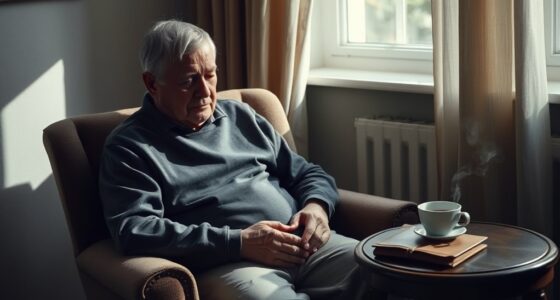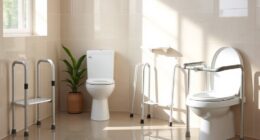To manage freezing of gait, guarantee the environment is clear, well-lit, and free of clutter to help your loved one navigate safely. Use assistive devices like canes or walkers properly fitted for comfort and confidence. Incorporate routine cues such as rhythmic tapping or verbal prompts to initiate movement. Encouraging steady walking pace and environmental consistency reduces surprises that trigger freezing. Support your loved one with familiar cues and strategies—learning more can empower you both to handle episodes confidently.
Key Takeaways
- Use assistive devices properly fitted to enhance stability and prevent falls during freezing episodes.
- Modify the environment by removing clutter, installing grab bars, and using lighting to reduce triggers.
- Implement rhythmic cues, such as tapping or music, to help initiate movement during freezes.
- Maintain a calm, predictable environment and use verbal prompts to guide movement.
- Encourage regular practice and confidence-building to improve safety and independence during gait challenges.

Freezing of gait can be a frustrating and unpredictable symptom, often making it difficult to move smoothly and confidently. As a caregiver, your goal is to help reduce these episodes and maintain your loved one’s independence. One effective way to do this is by incorporating assistive devices. Devices like canes, walkers, or specialized gait belts can provide stability and support, giving your loved one a sense of security when walking. Make sure these devices are properly fitted and comfortable, as they can make a significant difference in preventing falls during freezing episodes. Additionally, training your loved one to use these tools confidently can boost their confidence and reduce anxiety about walking.
Environmental modifications also play a fundamental role in managing freezing episodes. Clear pathways free of clutter make it easier to navigate and decrease the likelihood of tripping or falling. Installing grab bars in key areas like the bathroom or near stairs provides extra support and reassurance. Bright, consistent lighting helps eliminate shadows and visual cues that might trigger freezing. Consider adding contrasting tape or rugs with non-slip backing to mark doorways or steps, making these areas more visible. Keep frequently used items within easy reach to prevent unnecessary stops or reaching, which can trigger freezing. Creating a predictable, safe environment allows your loved one to move more freely and with less fear.
You can also help by establishing routines that reduce surprises or sudden changes in the environment. For example, encourage your loved one to take regular breaks during walks or daily activities to prevent fatigue, which can worsen freezing episodes. During walks, keep a steady pace and offer verbal cues like “let’s go” or “step forward,” which can serve as prompts to initiate movement. Reminding them to focus on specific steps or to use rhythmic cues, like tapping their foot or listening to music with a steady beat, can also help overcome freezing.
Frequently Asked Questions
How Can I Prevent Freezing Episodes Before They Start?
You can prevent freezing episodes by using environmental cues like visual markers or rhythmic cues to encourage steady gait. Gait training helps you learn strategies to recognize and manage triggers early. Stay alert to potential obstacles and maintain a clear walking path. Practicing these techniques regularly can improve your confidence and reduce the likelihood of freezing episodes, making your daily routine safer and more comfortable.
Are There Specific Medications That Help Reduce Freezing of Gait?
About 60% of Parkinson’s patients find certain medications helpful for reducing freezing of gait. Medication options like levodopa and dopamine agonists can improve movement and address symptoms. However, drug effectiveness varies between individuals, and some may experience side effects. Consult with a neurologist to determine the best medication plan for you, as they can tailor treatments to your specific needs, maximizing benefits while minimizing adverse effects.
What Safety Measures Can I Implement at Home for a Person With Freezing?
You can improve safety at home by making essential home modifications, like securing rugs, installing grab bars, and ensuring good lighting. Keep pathways clear of clutter, and consider using non-slip mats. Prepare an emergency preparedness plan, so you know what to do if a freezing episode occurs. These steps help prevent falls and keep your loved one safe, giving both of you peace of mind during challenging moments.
How Do I Handle a Freezing Episode in a Crowded or Public Place?
When a freezing episode hits in a crowded place, don’t panic; stay calm, and think of it as a storm passing. Use crowd management techniques by gently guiding your loved one to a quiet spot. Offer emotional support by reassuring them and encouraging slow, deep breaths. Keep communication clear, stay patient, and remind them they’re safe. Your calm presence helps them regain control and feel more secure amid the chaos.
Can Physical Therapy Improve or Reduce Freezing of Gait?
Yes, physical therapy can improve or reduce freezing of gait. Through targeted exercise therapy and gait training, you can strengthen your muscles and improve your walking patterns. A physical therapist works with you to develop personalized exercises that enhance balance, coordination, and mobility. Regular sessions can help you gain better control over freezing episodes, making walking safer and more confident. Stay committed to your therapy plan for the best results.
Conclusion
Dealing with freezing of gait can be challenging, but your support makes a real difference. By staying patient and using strategies like visual cues, you help your loved one regain confidence. Did you know that nearly 80% of Parkinson’s patients experience freezing at some point? Remember, small gestures of encouragement and understanding can considerably improve their quality of life. Keep learning and adapting—your dedication is essential in managing this condition effectively.









